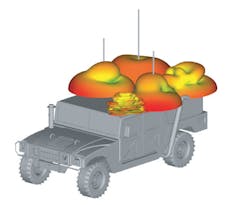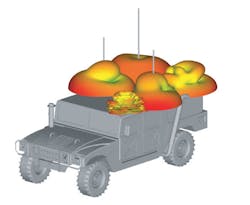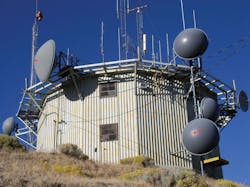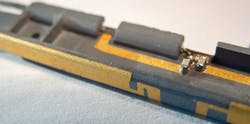This file type includes high resolution graphics and schematics when applicable.
Unless a radio installation is single-purpose and located far from any urban environment, it will undoubtedly have to overcome RF cosite issues. Cosite is a growing challenge for both RF system design engineers and radio technicians. As RF/microwave technologies become more accessible, so do the challenges of preventing these different RF systems from negatively impacting each other’s performance. Mitigating the interference impact of other radio systems is critically important for high-sensitivity, high-throughput, and mission-critical systems. Examples of these systems range from an unmanned aerial vehicle (UAV) to a tactical communications system on a naval ship or a wireless sensor platform in a mesh network (Fig.1).
For the vast majority of radio installations, troubleshooting cosite issues is a complex, time-consuming, and error-prone task. Compounding this scenario is the fact that it is difficult to predict cosite scenarios before they occur. As a result, it is challenging to determine the best-performing antenna configuration. The variables in the problem increase exponentially with the number of antennas involved.
Shawn Carpenter, vice president of marketing for Delcrosse Technologies, Champaign, Ill., provides an example. “Naval ships are floating antenna farms,” he says, “and there is a great deal of interaction between RF systems that must be considered. A natural concern for antenna placement in naval environments is that of coupling to the host vessel and to other antennas.” A specific challenge with naval vessels is that their radios range from redundant emergency radios in the megahertz range to millimeter-wave radar systems. This broad range of frequencies creates a nearly impossible troubleshooting scenario, as the equipment needed to measure all of these interactions would require tens of gigahertz of bandwidth.
Optimizing Antenna Placement
There is hope, though, as the latest EMI/cosite software has been developed using techniques that can optimize antenna placement. Such placement is based on profile models of commercial and military radios. Software suites, such as Ansys HFSS, FEKO, Delscrosse EMIT, Andro E3Expert, and others use specialized EM simulation techniques to efficiently gauge the performance of a variety of antennas and radio technology. To do this, they rely on antenna platforms imported from computer-aided design (CAD) models. Several of these software suites will even incorporate parameterized antenna models and simulate installed antenna performance and interactions from those models.
In a cosite prediction, the power received by the different antennas must typically be accounted for with each piece of radio hardware. Best practices—often developed by field experience in optimizing antenna placement—would be required to effectively use the information from the EM simulation (Fig. 2). However, it would be nearly impossible to account for nonlinearities, intermodulation distortion, reflections, mixing action, and other potential causes of re-radiated or internal interference. Fortunately, the latest software designed for cosite analysis and interference mitigation offers the ability to include system-level models of amplifiers, filters, cables, and even complete radios.
“Using asymptotic EM simulation, we can study the installed performance of individual antennas and arrays,” notes Carpenter. “EM simulation also enables us to perform antenna-to-antenna coupling in a fraction of the time and cost that would be required to install and measure these effects on an actual ship, for example.” For many simulation scenarios, the antenna platform could be highly complex and require more advanced computational enhancement techniques. Carpenter says, “These simulations make it possible to study a multitude of antenna placements in terms of their installed far-field radiation patterns, local RF intensity levels, sidelobe levels, and coupling to other antennas in the scenario. Once the antenna coupling between RF systems is understood, it is possible to progress to RF cosite interference mitigation.”
This file type includes high resolution graphics and schematics when applicable.
Analyzing the Simulation
This file type includes high resolution graphics and schematics when applicable.
Once the models of the antennas on the antenna platform are in place, the cosite simulation process incorporates those models into a cosite analysis mode or software package. Some of these software packages also include libraries of pre-built radio-configuration and component-level models, which allow a radio-hardware-inclusive cosite and interference simulation to be rapidly created. Including system- and component-level considerations enables transmit and receive paths to be considered separately. Self-interference effects can even be predicted.
To easily interpret the cosite and interference effects on the various transceivers, many of these software suites offer interference mapping. This aspect can be further investigated using one-on-one and multiple-on-one analysis. In addition to providing access to individual transceiver interactions, these tools can reveal the compound effects of either noise or direct interference on each individual receiver.
The quality and thoroughness of the EM simulation directly impacts the simulation’s ability to identify interference scenarios. For EM simulations, a more detailed simulation also demands more computational resources. That computational requirement grows as a function of rising frequency and larger total simulation area.
For example, a car may require simulation volume of roughly 5 × 3 × 2 m. At 2.6 GHz (a necessary simulation range to capture all common radio frequencies deployed in car scenarios), the car is beyond 40 wavelengths of the maximum simulation frequency. It therefore requires over 100 million mesh cells. In comparing mesh size to total simulation volume, the computational time necessary could be days—even with a high-performing computing platform.
GPUs Change the Game
To augment the computational power of a machine without demanding a significant investment, graphics processing units (GPUs) and software suites have recently been used. They are designed to profit from a GPU as a computing cluster.
Matthew Miller, president of Delcross Technologies, notes, “GPUs have been a game-changing technology for the SBR+ technique, providing anywhere from 20X to 200X acceleration factors with a single consumer-grade GPU card. For example, for a $300 to $400 investment in a GPU card, a simulation that used to take 24 hours to run now completes in under 15 minutes. We recently ran into a problem involving a 94-GHz antenna mounted to a Blackhawk helicopter. At 94 GHz, the Blackhawk is over 6000 wavelengths in dimension. Using a five-node cluster that we purchased for $20,000, we were able to compute the installed antenna performance in 143 seconds.”
Clearly, EM cosite and interference software is being rapidly developed to reduce interference—from a radio-hardware design perspective all the way to antenna and device placement. As wireless capabilities continue to be incorporated into virtually everything, however, the environment is only becoming more highly congested and interference-prone (Fig. 3). This issue applies whether the focal point is a connected home, automobile, or the body of the latest fighter jet.
Meanwhile, other issues are complicating these matters. Spectrum regulation, for example, was not designed to consider such a widespread demand for spectrum. Much like noise pollution in cities, the effects of ever-growing noise generators are creating a more complex and difficult environment for RF equipment, making it hard for that equipment to operate effectively. Thankfully, EM cosite and interference software is increasingly being used as an accepted best practice to meet the challenges of an ever-more-active wireless world.
This file type includes high resolution graphics and schematics when applicable.
About the Author
Jean-Jacques DeLisle
Jean-Jacques graduated from the Rochester Institute of Technology, where he completed his Master of Science in Electrical Engineering. In his studies, Jean-Jacques focused on Control Systems Design, Mixed-Signal IC Design, and RF Design. His research focus was in smart-sensor platform design for RF connector applications for the telecommunications industry. During his research, Jean-Jacques developed a passion for the field of RF/microwaves and expanded his knowledge by doing R&D for the telecommunications industry.




